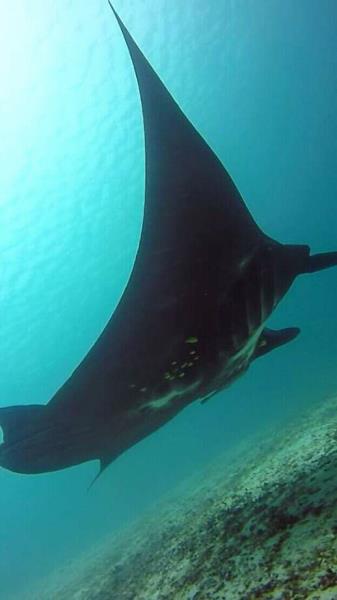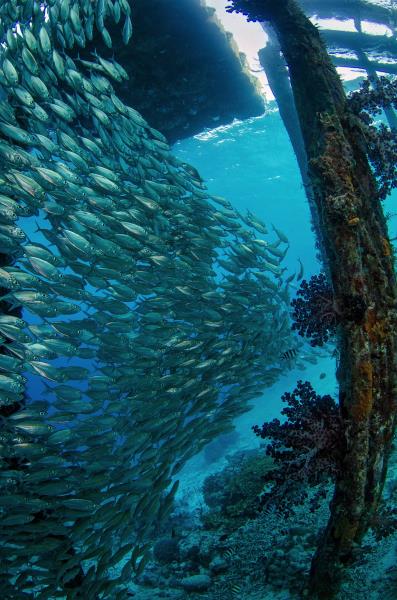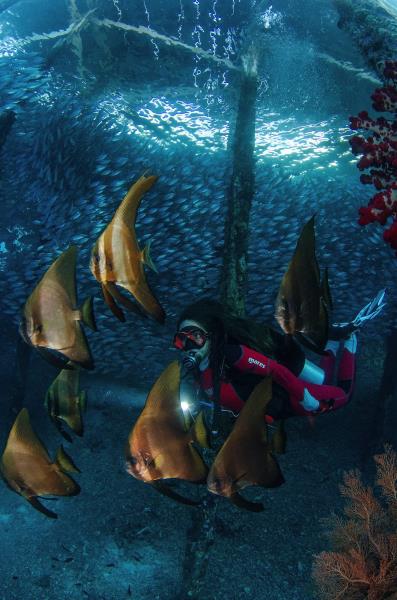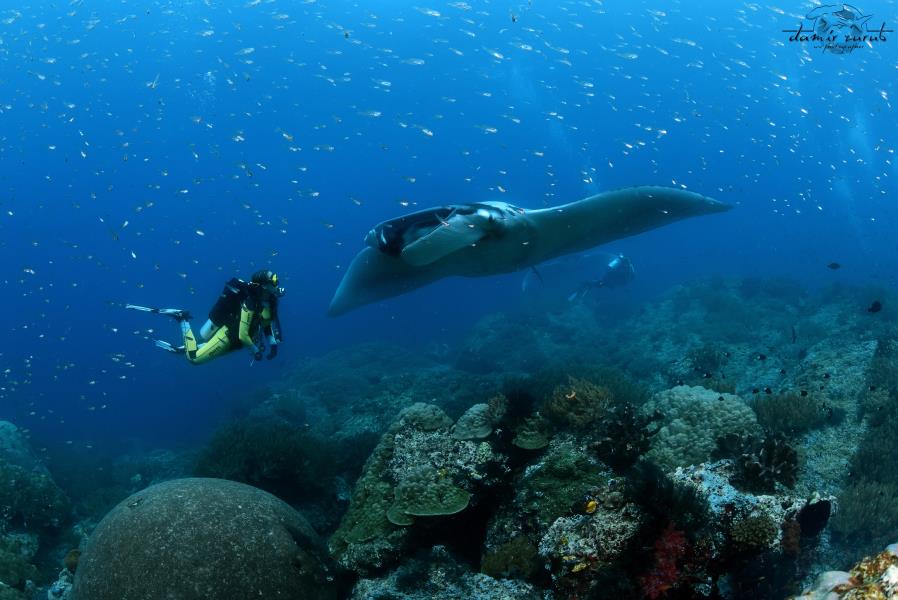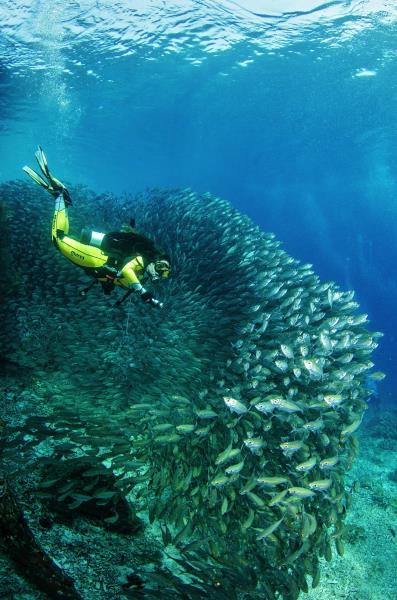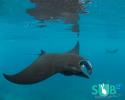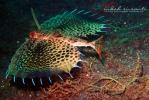 Advice on Scuba Diving in Raja Ampat, Indonesia
Advice on Scuba Diving in Raja Ampat, Indonesia
Part 1: Overview of Scuba Diving in Raja Ampat, (Indonesia)
Translated as ‘the Four Kings’, Raja Ampat is an archipelago situated off the island of New Guinea. Its 4 main islands of Misool, Salawati, Batanta and Waigeo are surrounded by over 1500 small islets, cays and shoals, creating literally countless reefs. Thanks to the area’s remote location and low population numbers, the reefs here have experienced relatively little damage from destructive fishing practices and it shows, because the reefs are healthy and teeming with life!
Raja Ampat is located in the Coral Triangle, the epicenter of marine biodiversity, and in the path of the Indonesian Throughflow, which ensures a constant source of nutrients. This combination makes it the most bio diverse marine area in the world. An astounding number of over 1400 fish species have been found here, of which over 35 endemic, together with more than 550 species of corals. Needless to say, Raja Ampat is a diver’s paradise.
The variation of dive sites in Raja Ampat is incredible. Sloping reefs, drop offs, caves, mangroves and muck dive sites, Raja Ampat has something to offer every diver and is an absolute heaven for underwater photographers. Strong deep-water currents attract large schools of fish and pelagic species like sharks and manta rays. Whereas the protected reefs and mangroves offer great shelter for smaller species and juveniles.
Due to the mild to strong currents in the area, live aboard diving on Raja Ampat consist mainly of drift diving and is not always suitable for beginners. That beings said, many of the dive resorts offer house reefs and muck dives that suit any level of diver. Diving in Raja Ampat can be divided in 3 regions; North, Central and South. Depending on the itinerary, liveaboards will visit one or more of these areas.
The best time to dive in Raja Ampat is between October and April. Most liveaboards tend to leave Raja Ampat between the months of June and September, due to strong winds, and station themselves in other diving destinations in Indonesia where the weather is more stable. Diving Raja Ampat in the low season is possible though, as some of the dive resorts stay open year round and the water temperature is a comfortable 28-30 Degrees Celsius throughout the year.
Part 2: Dive Sites, Marine Life & Environment in Raja Ampat, (Indonesia)
The Kri Islands in the Northern region of Raja Ampat is a frequented dive destination for most liveaboards. Diving the popular site Sardines you will soon find yourself surrounded by so many fish it’s hard to see past them. You will not find any sardines here, but the schools of Trevallies and Tuna are so tightly packed it’s easy to see where the name came from. Sel Pele, a large bay on the west side of Waigeo Island is known as one of Raja Ampat’s best sites for macro diving. Dive slowly and you can find a variety of cephalopods, nudibranchs, pipefish and pygmy seahorses. Other popular dive sites around Waigeo are Bird Wall and The Corner. Prepare for some currents at the latter one as the site is situated on the unprotected southwest site of the island.
The Jeff Fam group of limestone islands, in the central part of Raja Ampat, create many channels, coves and bays, which will ensure an incredibly varied dive experience. Batu Burung is a great site to spot the strangely interesting tasseled Wobbegong shark. But the area is also great for seeing hard corals, angelfish and giant Tridachna Clams. Manta Ridge, as the name implies, is an excellent site to see the glorious manta ray. This cleaning station attracts large numbers of manta rays, which seemingly line up for their turn. Divers just steady themselves in a spot and stay there to watch the action, while the manta rays glide past them.
Southern Raja Ampat dive site Fabiacet is many diver’s dream reef. This set of pinnacles has a dramatic topography and gets amazing visibility creating a spectacular backdrop for the wide-angle photographer enthusiast. You will find beautiful masses of gorgonians and sponges along the channels and if you keep your eyes on the deep blue, you may spot an occasional Great Hammerhead shark or other pelagic species. Another southern favorite is Boo island, a beautiful vibrant reef that hosts a wealth or marine life including stunning soft corals, octopus and green turtles.
Part 3: Dive Shops, Airports & Logistics of Diving in Raja Ampat, (Indonesia)
Diving in Raja Ampat is done either by liveaboard or from a dive resort. There are many liveaboard boats operating in Raja Ampat with different itineraries offering the best opportunity to cover a large area and variety of dive sites. Both Mermaid Liveaboards and the Aggressor fleet are well-established liveaboard operations with several ships, routes and itineraries in Raja Ampat. For a more boutique experience, the Arenui is a traditional Indonesian wooden ship made by hand mostly from recycled wood and comes completely with wood carved details from Bali and Java.
Pick one of Raja Ampat’s many dive resorts if you prefer to stay on land and have more freedom to do other activities. There are resorts for different budgets, which allow you to tailor make your own dive itinerary. Local homestays offer the cheapest way to dive Raja Ampat, but extra care should be taken in to make sure your homestay or local dive shop operates safe dive practices. The Raja Ampat Biodiversity Resort, Kri Eco Resort and Wicked Diving are all good options within the mid budget range. For divers with less of a budget restrain the Misool Eco Resort and Papua Paradise Eco resort are some beautiful boutique choices. Dive packages usually include local dives and a supplement is charged for dive sites that are further away.
The gateway to diving in Raja Ampat is Sorong, which has connections to Jakarta, Singapore, Makassar, Bali and Manado. Both Jakarta and Singapore have the best international connections. Domestic airlines that fly to Sorong include Sriwijaya Air, Express Air, Garuda Indonesia and Lion Air. Some routes will have a stopover in Manado.
From Sorong there are both speed boats and slow boats to get to the islands of Raja Ampat, which take anywhere from between 1-4 hours depending on the location of the resort. Divers that book with a resort or liveaboard often receive free boat transportation on selected days. Before heading out to the dive sites, it is compulsory to get a permit from the local Papua police station.---- Book Your Diving ----
Fill in the Form Below.
Our hand picked regional partners will deliver no obligation quotes.
Tweets by @DiveAdvisorApp
Top Dive Shops
Top Dive Sites
Cities
Reviews
Dive Logs
-
bill6688 Sunday, December 20, 2015
HEAD KM Ocean Rover Misool Island and Raja Ampat Islands view log
Dive Types & Activities
- Reef Dive
- Underwater Photo & Video





